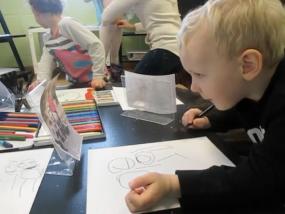Drawing from a Photograph

In this video, four-year-old Matthew draws members of his family, using a photograph to support him. He begins by drawing his dad, starting with his head. Matthew draws a circle and says, “Ta-da!” He refers back to the photograph (00:15) as he decides what feature(s) to add next and says, “And then, we have, eyes!” Matthew demonstrates a sense of proportion as he positions the eyes halfway down the face. Next, Matthew represents the mouth by drawing a horizontal line on the lower portion of the circle (00:27). Perhaps further indicating Matthew’s sense of his dad’s facial proportions as represented in the photograph, he places the mouth between the eyes and the bottom of the circle.
After pausing to look at his paper, Matthew decides to revise his drawing by extending the line of the mouth to meet the edge of the circle on both sides (00:33). By doing so, Matthew creates a relationship between the marks he has made on his paper; he constructs a mark-to-mark relationship, rather than a mark-to-referent (photograph) relationship. As Matthew shifts his focus from the photograph to his drawing, he may experience a sense of tension between his desire to add marks that represent his family as depicted in the photograph, and his desire to create relationships between the marks he has placed on the paper. The gap between the circle and the horizontal line creates a mark-to-mark tension that he needs to resolve by filling in the gap. When one creates a symbol, one also considers rules of the marks (i.e design) as well as rules of capturing a likeness to a referent (i.e. representation).
He studies the photograph and at time code 00:45, Matthew draws a circle for the tummy. He then says, “Wait. That’s not right.” This is an interesting moment as the child again pauses to reflect on his drawing. Matthew may be comparing the tummy he has drawn to the depiction of his dad in the family photograph, or he may be considering the tummy with regard to the size and proportion of the other marks he has made on his paper. The circle (tummy) may closely resemble the proportion of his dad as seen in the photograph, but Matthew likely decides that the size of the tummy does not make sense in relation to the size of the circle he has drawn to symbolize his head. The teacher says, “You can just draw over it,” and Matthew shows flexibility in his emotional development by accepting her suggestion.
In a manner similar to conducting inventory, Matthew continues drawing as he says, “One arm. Two arms.” Notice that he leaves a bit of space between the features – slight gaps between the head, tummy, and arms, perhaps as a way to set down bearings for his dad’s form. One wonders if Matthew might approach drawing differently if he were drawing his family while looking at real people instead of a photograph, or drawing his own face reflected in a mirror. A photograph is itself a symbol, once removed from the actual subjects, and does not include the dynamics of movement and expressivity that one can see in real people or by looking in a mirror. Drawing from a photograph likely does not afford one the same emotional connections that are available when drawing from observation. As such, a photograph may invite a more schematic approach by encouraging one to copy shapes and lines, and to record features.
Matthew refers back to the photograph and adds two legs by drawing vertical lines down from the tummy (01:23). As he looks down at his paper, Matthew again considers the mark-to-mark relationship between the lines he has made. He decides to make a revision by extending the length of the leg on the left so that it matches the length of the leg on the right (01:30 – 01:32).
He completes his dad’s figure by adding two feet, each pointing out to the side in opposite directions. Matthew knows that if he draws the feet straight down they will be indistinguishable from the legs. He likely is not thinking about the function of the feet, as it would be challenging to walk with one’s feet pointing in opposite directions. Rather, he may seek to maintain the sense of symmetry in his drawing; drawing the feet pointing in the same direction (both to the left, or both to the right) might disrupt his sense of aesthetic balance. All and all we view this short episode as a reminder that drawings will have more power and expressivity if preformed in the context of something emotional, such as the poppy drawings made by the young children in Reggio Emilia after they spent a morning running through a poppy field on a beautiful spring day (See The Hundred Languages of Children, 1st Edition, by Edwards, Gandini, and Forman).
Length of video: 2 minutes and 39 seconds
Keywords: fours, markers, drawing, family, representation, relationships
